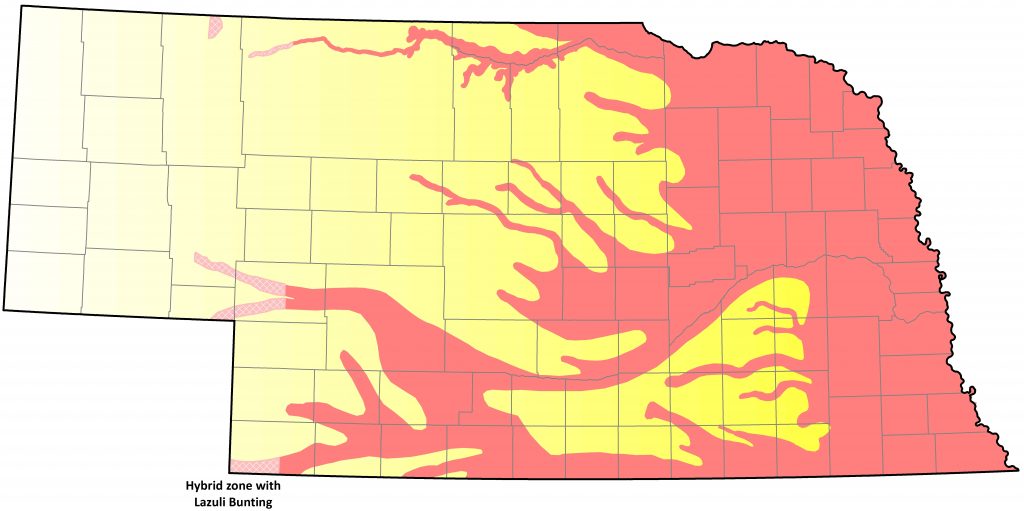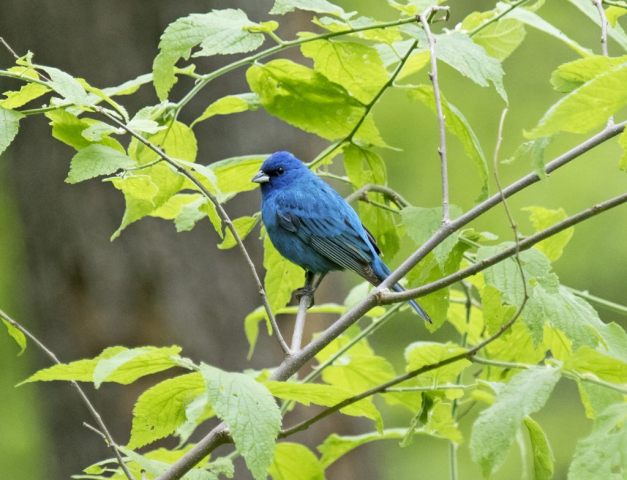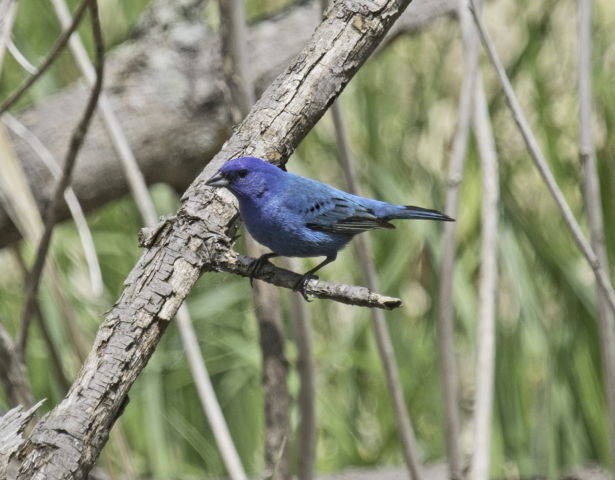Passerina cyanea
Status: Common regular spring and fall migrant and breeder east and east-central, uncommon west-central, rare west.

Documentation: Specimen: UNSM ZM7099, 15 Aug 1899 Lancaster Co.
Taxonomy: No subspecies are recognized (AviList 2025).
This species hybridizes with Lazuli Bunting; see the Lazuli x Indigo Bunting (hybrid) species account.
Changes Since 2000: The increasing number of reports in the Panhandle, especially in Scotts Bluff Co, suggests continuing westward movement of the range of this species; as pointed out by Carling and Zuckerberg (2011), the hybrid zone between this species and Lazuli Bunting is shifting westward also.
Spring: Apr 25, 26, 26 <<<>>> summer
Earlier dates are 16-19 Apr 2009 photo Ogallala, Keith Co, 17 Apr 2016 Cass Co, 19 Apr 2012 Lancaster Co, 19 Apr 2024 Douglas Co, 21 Apr 2013 Otoe Co, and 23 Apr 2022 Douglas Co.
Migrants arrive in late Apr.
There are numerous reports in the Panhandle, with the number of reports increasing in recent years as the hybrid zone shifts slowly westward (Carling and Zuckerberg 2011).
A study by Jorgensen and Brenner (2024) found that spring arrival dates had advanced by 14 days from 1938 to 2024.
- High counts: 45 in Otoe Co 16 May 2003, 40 at Fontenelle Forest, Sarpy Co 10 May 2019, 35 there 3 May 2012, and 35 there 21 May 2017.
Summer: Around 1900, this species apparently bred only in the east, westward to the Grand Island, Hall Co area (Bruner et al 1904). As recently as 1958 this was still the case (Rapp et al 1958), although a specimen, UNSM ZM10413, an apparent phenotypically pure male, was taken at Glen, on the White River in Sioux Co, as long ago as 18 Jul 1910. Indigo Bunting has spread westward since the 1950s along major river valleys, most notably those of the Niobrara and Platte; it is these two areas where contact with Lazuli Bunting has resulted in the most obvious hybridization (Short 1961).
Highest breeding densities are in the Missouri River Valley; the four BBS routes with highest numbers are in counties adjacent to the Missouri River. Away from the Missouri River Valley, Indigo Bunting is most numerous in the Niobrara River Valley. In one estimate, it outnumbered Lazuli Bunting by 40:1 as far west as eastern Cherry Co (Mossman and Brogie 1983). In the late 1950s it was not found west of Valentine in Cherry Co (Short 1961), and Rosche (1982) considered it apparently occurred in small numbers farther west in the Niobrara River Valley (Rosche 1982), but since 2011 there have been several reports farther west in Cherry Co, at NNF McKelvie 5 Jun 2011, the 16F Road crossing of the Niobrara River 7 Jun 2022 and 14 Jun 2016, along the Niobrara River south of Nenzel 13 Jun 2002, and south of Nenzel 8 Jun 2022.
According to Johnsgard (1980), Indigo Buntings breed throughout the Platte and South Platte river valleys to Colorado but are few in the North Platte River Valley. Breeding west of Keith Co along the North Platte River Valley is limited; most males in the Keith Co area were said to be hybrids with white abdomens (Rosche 1994, Johnsgard 1990), although Brown et al (1996) recorded only four birds with hybrid characteristics among 28 Indigo Buntings netted at Lake Ogallala. Rosche (1994) noted that Indigo Bunting had increased as a breeding species in the Keith-Garden Cos area around Lake McConaughy during the 1980s; it is possible that the incidence of hybrids in Keith Co has been reduced as numbers of Indigo Bunting have increased and the hybrid zone has shifted westward (Carling and Zuckerberg 2011). There are recent reports from Crescent Lake NWR, Garden Co, although none later than 9 Jun, suggesting that only migrants have occurred there.
There are several breeding season reports from the Scotts Bluff Co area, beginning in 1981, but most since 2014; recent reports suggest nesting occurs in the Wildcat Hills and Scotts Bluff NM areas, from which there are four and eight reports respectively as of Aug 2019, including seven at Wildcat Hills 12 Jun 2014. A pair exhibiting agitated behavior was at Carter Canyon, Scotts Bluff Co 13 Jul 2023. One at Scottsbluff WTP, Scotts Bluff Co 25 Jul 2024 may have dispersed from a nearby breeding location.
Indigo Buntings are common south of the Platte River Valley.
In the northwest, Rosche (1982) noted that it occurred in about the same numbers as Lazuli Bunting on the Pine Ridge, being most common in the Chadron, Dawes Co section of the White River drainage. Rosche (1982) “strongly suspects” however that there are “few, if any, pure Indigo Buntings present during the nesting season,”; most territorial males show some white on the abdomen. Reports since, however, suggest substantially greater numbers of Lazuli Buntings than Indigo Buntings on the Pine Ridge (eBird.org, accessed Jan 2024).
BBS data analysis (Sauer et al (2020) showed stable numbers in the state 1966-2019; annual change was -0.17% (C.I. -0.99, 0.69).
- Breeding phenology:
Nest building: 11 May-28 Jul - Eggs: 10 Jun- 27 Jul (Mollhoff 2022)
Nestlings: 18 Jun-15 Jul
Fledglings: 13 Jul-7 Sep
- High counts: 23 at Indian Cave SP, Richardson Co 12 Jul 2020, 14 there 30 Jun 2024, 14 in southern Richardson Co 16 Jul 2024, and 14 at Branched Oak Lake, Lancaster Co 28 Jul 2024.
Fall: summer <<<>>> Oct 10, 11, 11
Later dates are 16 Oct 2012 immature male Dixon Co, and 4 Nov 2024 Lincoln, Lancaster Co.
Amazingly, an immature remained at a Dixon Co feeder 19 Dec 1998-2 Jan 1999; NOURC concluded that other Passerina buntings could not be eliminated from consideration, however (Jorgensen 2001).
Away from the east, late dates include 23 Sep 1909 Lancaster Co (specimen UNSM ZM10655), 25 Sep Dawes Co (Rosche 1982), 27 Sep 2015 one banded at Chadron SP, Dawes Co, 30 Sep 2001 immature male NNF Bessey, Thomas Co, 2 Oct 1992 Dawes Co, and 9 Oct 2005 Furnas Co.
- High counts: 16 at Fontenelle Forest, Sarpy Co 6 Aug 2024, 14 in Lancaster Co 1 Aug 2021, 13 at DeSoto NWR, Washington Co 7 Aug 2021, and 13 at Fontenelle Forest, Sarpy Co 22 Aug 2022.
Images
Abbreviations
BBS: Breeding Bird Survey
NNF: Nebraska National Forest
NM: National Monument
NOURC: Nebraska Ornithologists’ Union Records Committee
NWR: National Wildlife Refuge
SP: State Park
UNSM: University of Nebraska State Museum
Literature Cited
AviList Core Team, 2025. AviList: The Global Avian Checklist, v2025. https://doi.org/10.2173/avilist.v2025.
Brown, C.R., M.B. Brown, P.A. Johnsgard, J. Kren, and W.C. Scharf. 1996. Birds of the Cedar Point Biological Station area, Keith and Garden Counties, Nebraska: Seasonal occurrence and breeding data. Transactions of the Nebraska Academy of Sciences 23: 91-108.
Bruner, L., R.H. Wolcott, and M.H. Swenk. 1904. A preliminary review of the birds of Nebraska, with synopses. Klopp and Bartlett, Omaha, Nebraska, USA.
Carling, M.D., and B. Zuckerberg. 2011. Spatio-temporal changes in the genetic structure of the Passerina bunting hybrid zone. Molecular Ecology 20: 1166-1175.
Johnsgard, P. A. 1980. A preliminary list of the birds of Nebraska and adjacent Great Plains states. Published by the author, University of Nebraska, Lincoln, USA.
Johnsgard, P.A. 1990. Additional observations of the birds of the Lake McConaughy region. NBR 58: 52-54.
Jorgensen, J.G. 2001. 1999 (Eleventh) Report of the NOU Records Committee. NBR 69: 85-91.
Jorgensen, J.G., and S.J. Brenner. 2024. The changing spring migration patterns of selected bird species in Nebraska 1938-2024. Joint Report of the Nongame Bird Program at the Nebraska Game and Parks Commission and Audubon Great Plains, Lincoln, Nebraska, USA.
Mollhoff, W.J. 2022. Nest records of Nebraska birds. Nebraska Ornithologists’ Union Occasional Paper Number 9.
Mossman, M.J., and M.A. Brogie. 1983. Breeding status of selected bird species on the Niobrara Valley Preserve, Nebraska. NBR 51: 52-62.
Rapp, W.F. Jr., J.L.C. Rapp, H.E. Baumgarten, and R.A. Moser. 1958. Revised checklist of Nebraska birds. Occasional Papers 5, Nebraska Ornithologists’ Union, Crete, Nebraska, USA.
Rosche, R.C. 1982. Birds of northwestern Nebraska and southwestern South Dakota, an annotated checklist. Cottonwood Press, Crawford, Nebraska, USA.
Rosche, R.C. 1994. Birds of the Lake McConaughy area and the North Platte River valley, Nebraska. Published by the author, Chadron, Nebraska, USA.
Sauer, J.R., W.A. Link and J.E. Hines. 2020. The North American Breeding Bird Survey – Analysis Results 1966-2019. U.S. Geological Survey data release, https://doi.org/10.5066/P96A7675.
Short, L.L., Jr. 1961. Notes on bird distribution in the central Plains. NBR 29: 2-22.
Recommended Citation
Silcock, W.R., and J.G. Jorgensen. 2025. Indigo Bunting (Passerina cyanea). In Birds of Nebraska — Online. www.BirdsofNebraska.org
Birds of Nebraska – Online
Updated 24 Jul 2025


